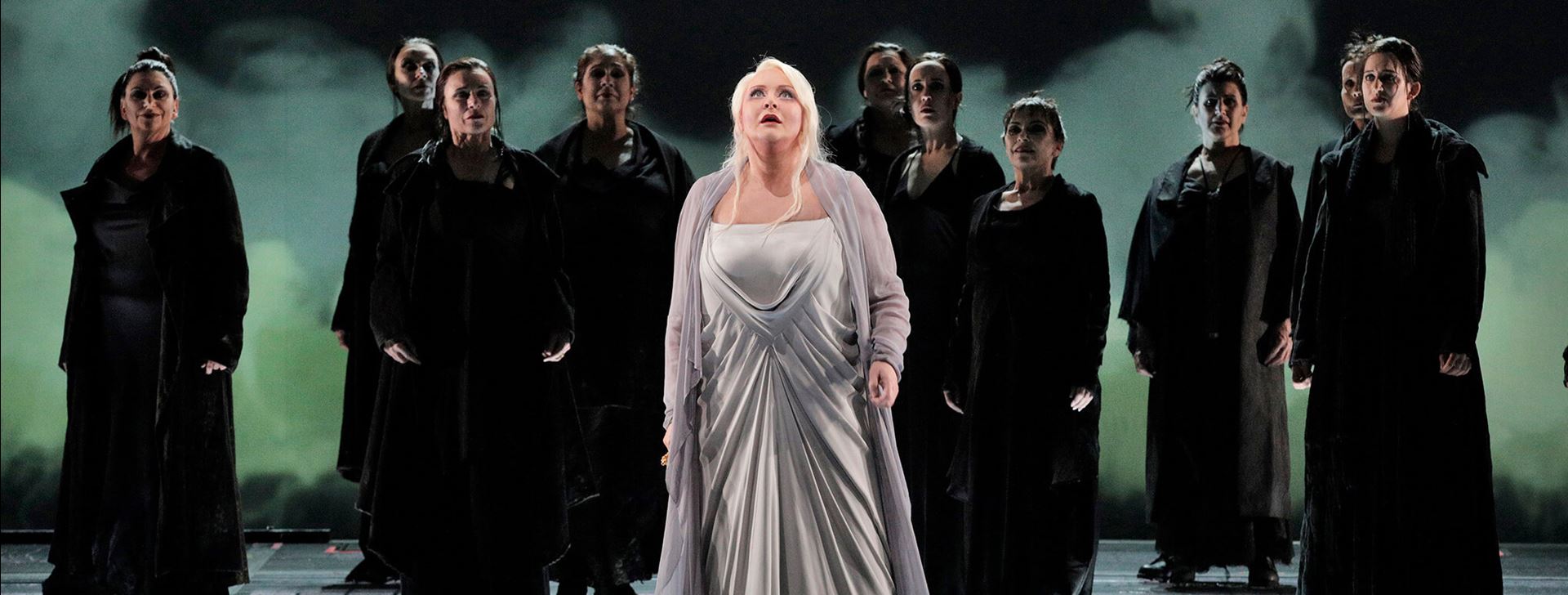
Five Badass Heroines Who Will Change the Way You Look at Opera
Female opera characters have long been labeled as damsels, divas, and everything in between. Let’s take a closer look at a few heroines who defy categorization.
Female characters are the backbone of too many operas to count. Even operas that focus on a central male figure, like Wolfgang Amadeus Mozart’s Don Giovanni or Gioachino Rossini’s The Barber of Seville, often have a female figure driving the action both onstage and off.
It's time to turn the spotlight on them. Check out five of our favorite opera heroines—dagger-wielding, gun-toting, hard-knuckled badasses who will change the way you think of opera. Read on to see if your favorite is on the list!
Brünnhilde Minnie Tosca Carmen Leonore Going Beyond Stereotypes
Brünnhilde
The Ring Cycle (Der Ring Des Nibelungen) by Richard Wagner, 1876
It’s impossible to make a list of impressive opera heroines without including Brünnhilde, a valkyrie from Wagner’s Ring cycle. The daughter of Wotan, the king of the gods, Brünnhilde is a woman defined by her bravery, intelligence, and unwavering self-confidence. After blatantly disobeying her father's command—to let her half-brother die in battle—she is banished to a mortal life and placed in a magical sleep, only to be awakened by a warrior strong enough to match her.
At the end of Götterdämmerung, the Ring cycle’s final opera, Brünnhilde makes the ultimate sacrifice. She takes control of the ring of power, a circlet of gold cursed to create bloodshed wherever it goes—and instead of using it for her own advancement, she steps into a raging fire, offering her life to cleanse the ring of its curse. Brünnhilde’s martyrdom comes at the cost of everyone she once held dear, and yet she is calm and unwavering in her decision to do the right thing. It’s hard to think of a heroine—in opera or elsewhere—more impressive than that!
Minnie
The Girl of the Golden West (La Fanciulla Del West) by Giacomo Puccini, 1910
Minnie is another opera heroine who knows what’s right and isn’t afraid to do a little wrong to make it happen. As a saloon-owning, gun-wielding woman in the 19th century, Minnie is a gal who truly takes control of her destiny. She saves Johnson (her friend and, later, lover) from the gallows not once but twice—first by cheating and winning a poker match with Sheriff Rance and later by convincing the miners who frequent her saloon to call off Johnson’s execution.
Along with showing true grit, Minnie also follows her heart unabashedly. After brushing off Rance’s attempts at love, she quickly falls for Johnson and vows to stop at nothing to be with him. Unlike many other opera heroines, Minnie gets the good ending she deserves. After saving Johnson from the gallows, Minnie and her new beau ride off into the sunset and live happily ever after. It feels like there’s little more to say about Minnie except: You go, cowgirl!
Tosca
Tosca by Giacomo Puccini, 1900
There’s a reason why Puccini’s famous opera Tosca is titled after its lead female character — and it’s not just because she’s an opera singer herself. Tosca is a woman who, even when at the mercy of men, lives life on her own terms.
In a last-ditch attempt to save her condemned lover Mario Cavaradossi, Tosca agrees to a horrific scheme designed by the police chief, Scarpia: Tosca will give herself to Scarpia and, in return, he will free Cavaradossi. She watches as Scarpia appears to arrange a staged execution, which will allow the lovers to flee in secret.
But as soon as Scarpia begins to advance on her to receive his side of the bargain, Tosca grabs a knife from his desk, stabs him to death, and flees. She runs to the prison to tell Cavaradossi of his imminent freedom, and together they sing of a happy future. Sadly, that happiness is short-lived, as it quickly becomes clear that Scarpia gave an order that ensured Cavaradossi would still be killed despite his promise to Tosca.
Upon seeing Cavaradossi’s dead body—and with the police pursuing her for Scarpia's murder—Tosca jumps to her death from a prison battlement. As she leaps, Tosca vows she’ll meet Scarpia before God—implying that her revenge is just beginning. Through her actions, Tosca maintains control over her own life and death.
Carmen
Carmen by Georges Bizet, 1875
Perhaps one of the most famous, yet misunderstood, opera heroines of all time is Carmen. Always unapologetically herself, Carmen is an intelligent, passionate, and sexually liberated woman who simply can’t be tamed. Her headstrong behavior often lands her in trouble, but she manages to use her feisty combination of beauty and brains to find a way out.
Carmen captures the eye of many powerful men, but from her first moments on stage, she makes her intentions clear: "If you don't love me, I'll love you—but if I love you, be careful!" She's a contrarian, through and through. But her independent streak runs afoul of the morals of her age. When she takes the officer Don José as her lover, she triggers a sense of entitlement in him that teeters into obsession. After discovering that Carmen has moved on, Don José kills her in an act of vengeance.
By taking advantage of men the way they so often take advantage of women, Carmen subverts the usual gender hierarchy of the time. That made her incredibly controversial when her namesake opera debuted in 1875. Carmen was decried as a poor example of female morality, while her murderer, Don José, was perceived as the opera's tragic hero. Now, given the growing awareness of gender-based violence, Carmen is no longer perceived as a cardboard villain—the architect of Don José's demise. Rather, she is reimagined as a woman who forges her own path on the outskirts of society until violence ends her life.
Leonore
Fidelio by Ludwig van Beethoven, 1805
If you’re looking for a heroine who demonstrates unwavering courage and conviction—all while putting herself in the path of danger for the sake of love and justice—look no further than Leonore, the main character in Beethoven’s Fidelio.
The opera—Beethoven’s only one—tells the story of a brave woman who is willing to risk it all to discover the fate of her beloved husband, Florestan, a political dissident who disappeared two years before the opera’s action begins. While many presume that Florestan is dead, Leonore is determined to find out what actually happened. She suspects a government official named Don Pizarro of kidnapping him as revenge for criticism Florestan leveled at the politician. To investigate, Leonore disguises herself as a man named Fidelio and gets a job at Pizarro's prison, where she believes she might uncover clues about her husband's whereabouts.
Throughout the opera, Leonore brazenly challenges Don Pizarro, a man with seemingly limitless, tyrannical power, demonstrating a level of bravery that is impressive in any era—not just the French Revolutionary period that inspired the opera. Fidelio’s climax occurs when Leonore finds and frees Florestan right before Don Pizarro attempts to kill him, revealing her true identity as she pulls a pistol on her husband’s jailer.
Leonore’s ultimate success occurs because she refuses to turn a blind eye to the injustice that surrounds her, just like the revolutionary figures throughout history whom her character represents. By putting love and her ideals above her own safety, Leonore is able to take down a ruthless, corrupt official and free not only her beloved Florestan but also the other inmates unjustly imprisoned by Don Pizarro.
Going Beyond Stereotypes in Opera Heroines
When it comes to picking impressive, empowered female opera characters, it’s easy to feel spoiled by choice. With over 400 years of heroines to choose from, narrowing down a list of five is more than a little challenging. We gave it our best shot, but now it’s time to ask: What do you think? Did we cover all of your favorite opera heroines, or is there someone we missed? Perhaps you were desperate to see Musetta from Puccini’s La Bohème on the list. Or maybe you think we’re crazy to have skipped Susanna from Mozart’s The Marriage of Figaro. No matter who your favorite is, we want to hear about it! Contact us @SFOpera on Twitter, Instagram, and Facebook to share your thoughts.
Plus, check out our other blogs, like this one on the Brief History of Opera, and our website to learn more about what’s happening at the San Francisco Opera!


